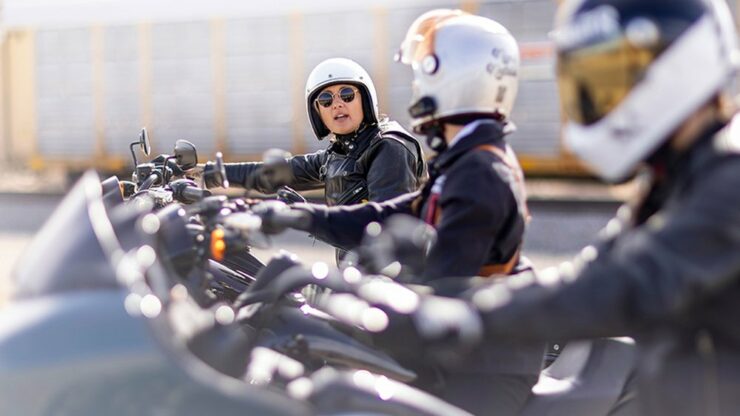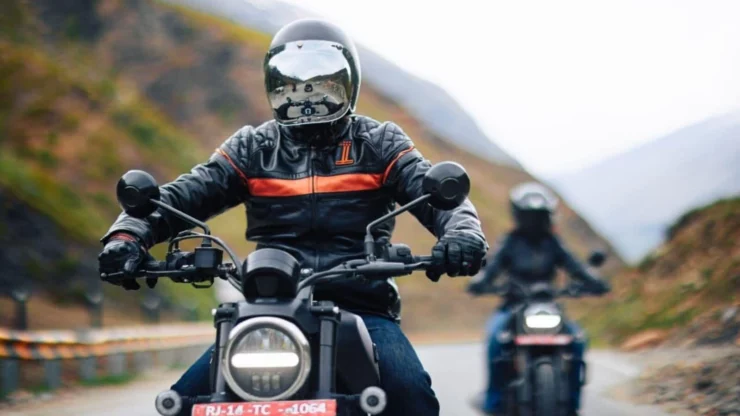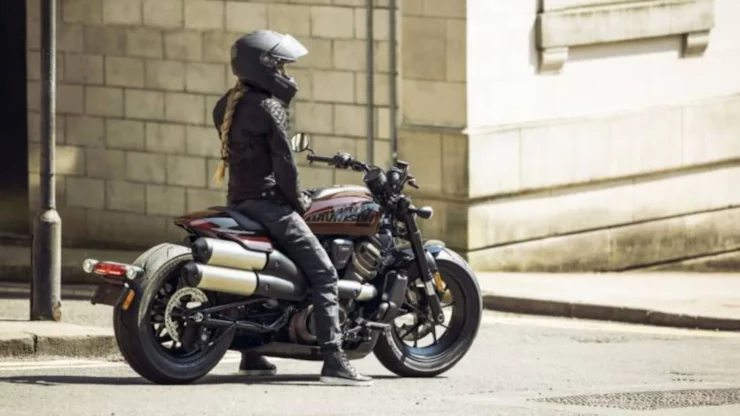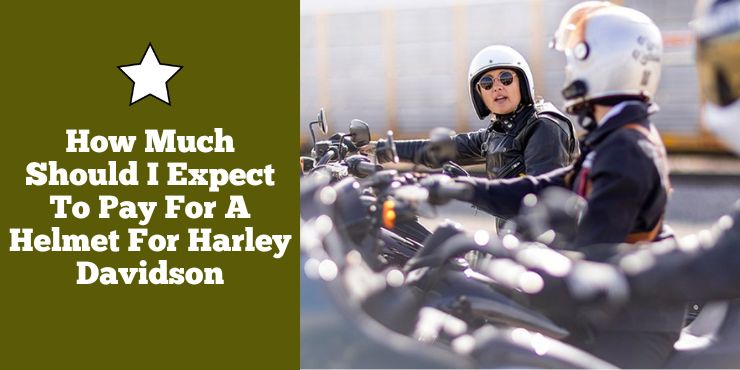Buying a new helmet for your Harley-Davidson motorcycle can be daunting, with so many choices available, it can be difficult to know what to expect in terms of cost. If you’re wondering how much you should expect to pay for a helmet, you’ve come to the right place!
Harley-Davidson helmets range from $100 to $600, depending on the style and features, with full-face and Bluetooth-enabled models being on the higher end.
In this article, we will discuss the different types of helmets available for Harley-Davidson motorcycles and the price range you should expect to pay for each type. Whether you’re on a budget or looking for the latest and greatest, we’ll help you find the perfect helmet for your riding needs. So, let’s get started!
How much should I expect to pay for a helmet for Harley-Davidson?
When it comes to motorcycle safety gear, a motorcycle helmet is a vital piece of equipment. A helmet will offer your head and face protection, keeping you safe and secure while also giving you personalization and customization options. If you’re in the market for a new motorcycle helmet, one of the questions you’ll have in your mind might be how much should I expect to pay for a helmet for Harley-Davidson riding? There are different types of helmets available in the market and each of them comes with its own set of features. Here are some of the helmets available for Harley-Davidson riders and how much you should expect to pay for them –
#1. Full-face helmets
A full-face helmet is a type of motorcycle helmet that offers coverage for the entire head, including the face. It features a sturdy outer shell made of materials like fiberglass, carbon fiber, or polycarbonate, which offers impact resistance and protection against head injuries during accidents. The helmet is designed to fit snugly around the head, with a chin bar that extends down to cover the lower face and jaw.
>>> Click here to read our review of the Best Helmet For Harley-Davidson <<<
Price range of full-face helmets
The price range of full-face helmets can vary depending on various factors, including the brand, materials used, and other features. Entry-level full-face helmets typically range from $100 to $300. These helmets offer basic safety features and tremendous protection, which makes them suitable for casual riders or those on a budget.
Mid-range full-face helmets typically range from $300 to $600. These helmets often come with advanced safety features, better aerodynamics, and improved ventilation systems, which makes them a popular choice for bikers who value both safety and performance.
Premium or high-end full-face helmets can range anywhere from $600 to $1000 or more. These helmets often incorporate cutting-edge technology, advanced impact protection systems, and lightweight materials. They might also offer additional features like integrated communication systems, anti-fog visors, and customizable fit options. These high-end helmets are often favored by professional riders or enthusiasts who prioritize top-of-the-line safety and performance.

Features of full-face helmets
Here are some of the key features of full-face helmets –
#1. Outer shell
Full-face helmets feature a durable outer shell made using materials like fiberglass, polycarbonate, or carbon fiber. These materials offer strength and impact resistance, ensuring optimal protection during accidents.
#2. Impact absorption
The inner liner of a full-face helmet is designed to absorb and distribute impact energy, reducing the force transmitted to the head in the event of a crash. Common materials used for liners include expanded polystyrene (EPS) foam.
#3. Visor and face shield
Full-face helmets feature a built-in visor or face shield that offers protection against wind, debris, and UV rays. Many helmets feature a scratch-resistant coating, anti-fog properties, and easy-to-use mechanisms for quick visor changes.
#4. Ventilation system
To enhance comfort, full-face helmets incorporate ventilation systems. These systems consist of vents located on the chin bar, forehead, and rear of the helmet, allowing for airflow and preventing fogging.
#5. Padding and interior
Full-face helmets come with removable and washable interior padding for a comfortable fit. High-quality helmets might also have moisture-wicking properties to keep the rider cool and dry during long rides.
#2. Half-face helmets
A half-face helmet is a type of motorcycle helmet that covers the top and sides of the head, leaving your face exposed. These helmets feature a protective outer shell made using materials like polycarbonate, fiberglass, or carbon fiber. The design of a half-face helmet allows for increased airflow and a wider field of vision compared to full-face helmets. While they tend to offer less coverage than full-face helmets, they still offer essential protection for the head. Half-helmets are commonly preferred by bikers who want a balance between protection and ventilation.
Price range of half-face helmets
The price range of half-face helmets can vary depending on different factors, including the brand, materials used, features, and more. Entry-level half-face helmets typically range from $50 to $150. These helmets offer basic safety features and they’re suitable for riders on a budget or those who prefer a simpler design.
Mid-range half-face helmets fall within the $150 to $300 price range. They often feature improved comfort, additional safety features, and better build quality. Helmets within this range might incorporate advanced materials and design elements that enhance protection and durability.
Premium or high-end half-face helmets can range from $300 to $600 or more. These helmets offer advanced features like integrated Bluetooth communication systems, superior ventilation systems, and high-quality materials for increased impact protection. They cater to bikers who prioritize advanced technology, comfort, and premium craftsmanship.
Features of half-face helmets
Here are some of the key features of half-face helmets –
#1. Outer shell
Half-helmets are constructed with durable outer shells made using materials like polycarbonate, carbon fiber, or fiberglass. These materials offer impact resistance and protection against head injuries.
#2. Inner padding
The inner padding of a half-face helmet provides a comfortable and secure fit. It is often removable and washable, allowing bikers to maintain cleanliness and hygiene.
#3. Visor or shield
Many half-face helmets come with a built-in visor or shield for protecting the eyes from wind, debris, and sunlight. Some visors also have anti-scratch or anti-fog properties for enhanced visibility and longevity.
#4. Ventilation system
Half-face helmets typically feature ventilation systems that promote airflow to keep riders cool during hot weather. These ventilation systems consist of vents located on the top or sides of the helmet, allowing for adequate air circulation.
#5. Retention system
Half-face helmets come equipped with a retention system, typically a chin strap to ensure a secure fit. The strap is adjustable and secures the helmet in place during rides.
#3. Open-face helmets
An open-face helmet is a type of motorcycle helmet that covers the top, sides, and back of the head, leaving the face entirely exposed. It features a protective outer shell typically made up of materials like polycarbonate or carbon fiber. These helmets offer more ventilation, a wider field of vision, and a sense of freedom compared to full-face or half-face helmets. Although they do offer less coverage, they still offer essential head protection.
Price range of open-face helmets
The price range of open-face helmets can vary based on factors like brand, design, material, and additional features. Entry-level open-face helmets generally range from $50 to $150. These helmets offer basic safety features and are ideal for casual riders or people on a budget.
Mid-range open-face helmets typically fall within the $150 to $300 price range. They often feature improved comfort, enhance safety features, and better build quality. Helmets in this range might incorporate advanced materials and design elements that offer increased impact protection and durability.
Premium or high-end open-face helmets can range from $300 to $600 or more. These helmets offer advanced features like high-quality materials, custom fit options, superior ventilation systems, and more. These helmets cater to bikers who prioritize advanced technology, comfort, and premium craftsmanship.
Features of open-face helmets
Here are some of the key features of open-face helmets –
#1. Retention system
Open-face helmets come equipped with a retention system, usually a chin strap for ensuring a secure fit and helmet stability during rides.
#2. Visor or shield
A few open-face helmets come equipped with a built-in visor or shield for protecting the eyes from wind, debris, and sunlight. The visors offer options for tinted, clear, or transitional lenses to cater to different lighting conditions.
#3. Inner padding
The inner padding of an open-face helmet is designed for providing comfort, a secure fit, and impact absorption. It is removable and washable to help maintain hygiene and freshness.
#4. Ventilation system
Open-face helmets typically come with ventilation systems for ensuring adequate airflow and reduce discomfort caused by heat and humidity. Ventilation might be provided through vents located on the top, front, and back of the helmet.
#5. Optional accessories
Some open-face helmets offer optional accessories like removable peak visors, detachable ear pads for noise reduction, or compatibility with communication systems for easy communication.

Different variables that affect the prices of motorcycle helmets
Motorcycle helmets are an important piece of safety gear that protect riders from potential head injuries. The price of a motorcycle helmet can vary significantly and several factors influence these price variations. Here are some of the key variables that affect motorcycle prices –
#1. Material quality
The quality of materials used in manufacturing motorcycle helmets is an important factor that affects their price. High-end helmets typically utilize advanced materials like carbon fiber, Kevlar, or fiberglass composites. These materials offer excellent strength-to-weight ratios, better impact absorption, and enhanced durability.
Helmets made using premium materials tend to be more expensive because of their higher cost of production and the enhanced level of protection they provide. Entry-level helmets typically employ polycarbonate or thermoplastic shells, which offer adequate protection at a more affordable price point. While these materials might not match the performance of advanced composites, they still meet the necessary safety standards and offer a budget-friendly option for bikers.
#2. Brand reputation
The reputation and prestige associated with a particular helmet brand also influence its price. Established and reputable brands often invest quite a lot in research, development, and safety testing, which results in helmets with innovative features and exceptional build quality. Their long-standing reputation for producing reliable and high-performing helmets contributes to the higher price tag attached to their products.
Lesser-known or new brands might offer helmets at a lower price point to establish themselves in the market. While these helmets might still meet safety standards, they might not possess the same level of refinement or brand recognition as their more established counterparts.
#3. Safety ratings
Motorcycle helmet safety ratings like those provided by organizations like the Department of Transpiration and the Snell Memorial Foundation play a major role in determining prices. Helmets that meet or exceed the safety standards set by these organizations often carry a higher price due to the rigorous testing and certification processes involved.
Helmets with additional safety features like multi-density impact liners, integrated MIPS (multi-directional impact protection system), or enhanced energy management systems are often more expensive. These advanced safety technologies contribute to improved protection and a higher price point.
#4. Customization options
Customization options like color choices, graphics, or personalized designs can impact the price of a motorcycle helmet. Customized helmets require additional time, effort, and resources during the manufacturing process. Manufacturers might also charge a premium for customization services for accommodating individual preferences and aesthetic choices.
Customization can also extend to fit adjustments, compatibility with communication systems, and removable or interchangeable components. Helmets having extensive customization options tend to be pricier as they cater to bikers looking for a personalized and unique look.
Where to buy a Harley-Davidson helmet?
Harley-Davison is an iconic motorcycle manufacturer and it offers an impressive range of high-quality helmets to component their renowned motorcycles. When purchasing a new Harley-Davidson helmet, bikers have a lot of options available to them. Here are some of the different avenues for purchasing a Harley-Davidson helmet, highlighting the benefits and considerations associated with each option.
Harley-Davidson dealerships
Harley-Davidson dealerships are the primary source for purchasing authentic Harley-Davidson helmets. These authorized dealerships offer an extensive selection of helmets, allowing riders to try them on and receive personalized assistance from knowledgeable staff members. Some of the advantages of buying a helmet from a Harley-Davidson dealership are authenticity, fitting services, and expert guidance.
Buying a helmet from a Harley-Davidson dealership ensures that you’re getting a genuine product, with the assurance of quality and authenticity associated with the brand. The staff at Harley-Davidson dealerships are well-trained and knowledgeable about the different helmet models, sizing, and features. They can offer expert advice and assistance in finding the right helmet for your specific needs.
Trying on helmets at a dealership will allow you to assess the fit, comfort, and overall feel of the helmet. Dealership staff will help you find the right size and make any necessary adjustments for optimal fit.
Online retailers
Online retailers offer a convenient and accessible platform for buying a Harley-Davidson helmet. There are various reputable online stores that offer a wide range of helmet options. There are a number of benefits of buying a Harley-Davidson helmet online including wide selection, convenience, and competitive pricing.
Online retailers have a broader inventory compared to physical stores, offering a greater range of helmet styles, designs, and sizes to choose from. Online shopping will allow you to browse and purchase a helmet from the comfort of your own home. Moreover, it will also provide the flexibility to compare prices, read customer reviews, and research different helmet models.
They might also offer competitive pricing, occasional discounts, and promotions, allowing you to find a good deal on a Harley-Davidson helmet.
Local motorcycle stores
Local motorcycle stores, whether independently owned or part of a chain are another option for buying a Harley-Davidson helmet. These stores typically stock a wide variety of helmet brands, including Harley-Davidson. Some of the benefits of buying from local motorcycle stores include personalized service, the option for trying on and getting the perfect fitting, and immediate availability.
Local stores often provide personalized customer service, offering guidance and recommendations based on their expertise and knowledge of different helmet brands. Local stores allow you to buy a helmet and have it in your possession immediately without the wait typically associated with online orders. Similar to Harley-Davidson dealerships, local motorcycle stores typically offer the opportunity to try on different helmets, ensuring a proper fit and optimal comfort.

Advice for purchasing a Harley-Davidson helmet
When it comes to purchasing a Harley-Davidson motorcycle helmet, riders should always be open to taking advice from others. While heeding advice can help with potential savings, it is important to prioritize safety and ensure that the helmet meets your specific needs. Here are some of the important considerations and advice for purchasing a Harley-Davidson helmet.
#1. Research options and brands
Before buying a Harley-Davidson motorcycle helmet, you need to conduct thorough research on the various options and reputable brands available. You must understand the features, certifications, and safety standards that apply to motorcycle helmets. Going for a brand like Harley-Davidson is a smart choice as its helmets are known for their durability and reliability while they also have positive customer reviews. Make sure to familiarize yourself with the specific model and its specifications, ensuring it aligns with your requirements and preferences.
#2. Seek expert advice
It is recommended that you should seek advice from experts or knowledgeable individuals as they’ll be able to guide you through the process of buying a Harley-Davidson motorcycle helmet. Consult with experienced riders, motorcycle professionals, or helmet specialists as they’ll be able to provide valuable insights on what to look for and potential red flags to avoid. They’ll also be able to offer advice on helmet fitting, safety features, and potential concerns specific to used helmets.
#3. Try before you buy
Ideally, you should try the helmet on before you make the purchase. The fit will be important for both comfort and safety. Make sure that the helmet sits snugly on your head, with no pressure points or excessive movement. Check for proper alignment with your eyes, ensuring clear visibility without obstructing your vision. Consider the weight and balance of the helmet too as these factors can greatly impact comfort during long rides.
#4. Consider a used helmet
Another option that you can go for would be to buy a used helmet. If you’re buying a used helmet, there are certain things that you should check. Inspect the used helmet carefully for any signs of wear, damage, or deterioration. Check the shell for dents, cracks, or other structural issues. Look for signs of excessive impact or damage that might compromise the helmet’s protective capabilities. Assess the condition of the internal padding, ensuring it is intact, clean, and odor-free. It is also important to consider the helmet’s age as older helmets might have outdated technology or materials that no longer meet current safety standards.
#5. Check the safety standards and certifications
Make sure that the helmet you are buying meets the required safety standards and certifications. Look for labels or markings indicating compliance with recognized safety organizations like DOT (Department of Transportation) or ECE (Economic Commission for Europe) standards. Helmets that meet these standards undergo rigorous testing to ensure they offer adequate protection.
FAQ
What is the price range for helmets for Harley Davidson?
Helmets for Harley Davidson are available in a range of prices, from budget-friendly models at around $50 to premium models that can cost up to $400 or more. The exact price will depend on the type of helmet, features, and brand.
What should I consider when choosing a helmet?
When choosing a helmet for Harley Davidson, it’s important to consider safety, fit, comfort, and style. Make sure the helmet is certified by the Department of Transportation and meets safety standards. It’s also important to choose a helmet that fits properly and is comfortable to wear. Lastly, consider the style of helmet that best suits your needs.
What type of helmet is best for Harley Davidson?
The best type of helmet for Harley Davidson will depend on your own needs and preferences. For most riders, a full-face helmet is the best choice as it provides the most protection. However, if you prefer an open-face helmet, make sure it is certified for safety and fits properly. Additionally, there are also modular helmets and half-helmets available, so it’s important to consider which type of helmet is best for you.
>>> Read more about Helmets for Harley-Davidson Riders <<<

